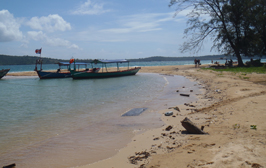The Post-War Pageantry of Miss Landmine
A woman, both of her legs amputated, wears a tiara and pageant sash and is carried by a young man and placed on a grouping of rocks in the surf. She screams as the cold water splashes against her body, soaking the bottom of her dress. Lighting rigs are placed and a photographer leans in,…

A woman, both of her legs amputated, wears a tiara and pageant sash and is carried by a young man and placed on a grouping of rocks in the surf. She screams as the cold water splashes against her body, soaking the bottom of her dress. Lighting rigs are placed and a photographer leans in, snapping photos. In the pageant world, or maybe just among pageant photographers, this is known as a mermaid shot. The mermaid at the center of this shoot, however, is the victim of an undetonated landmine in her home country of Cambodia, and a participant in the controversial post-war beauty pageant known as Miss Landmine. This scene, which opens producer/director Stan Feingold’s Miss Landmine documentary, captures the utter weirdness that permeates the pageant.
Founded in 2007 by Norwegian theater director Morten Traavik, the pageant seeks to raise awareness of the countless undetonated bombs and landmines left behind in war-ravaged countries such as Angola and Cambodia. Its parallel mission is best encapsulated in a phrase pulled from the organization’s manifesto: “Everybody has the right to be beautiful.” The focus here, according to Traavik, is to empower women who have suffered greatly as a result of war. The text of the manifesto places emphasis on the idea of transforming pageant contestants from “victims” to “survivors,” and challenging established perceptions of beauty and “physical perfection.” Winners in the pageant receive a custom-made prosthetic limb and prize money.
Miss Landmine documentary, Part 1 of 8. Complete series here.
But controversy hangs over the pageant due to Traavik’s method for achieving his outlined goals, namely by using a beauty pageant (an event often considered inherently sexist by nature) as a means for raising awareness of the landmine problem and those injured. The women crowned Miss Landmine — Agusta Urica (2008) and Dos Sopheap (2009) — each received custom-made prosthetic limbs and $1000 cash. And while the Angolan government embraced the pageant in 2008, Cambodian officials were less than welcoming.
In August of 2009, the Cambodian government banned the pageant, claiming it was an insult to the disabled. According to the Association of Women’s Rights in Development (AWID), a group skeptical of Traavik’s intentions, the pageant had to relocate before a winner was crowned:
After some unsuccessful appeals [to the Cambodian government] and in the face of strong criticism, Traavik and his team left Cambodia but continued the pageant in Norway, where the local Cambodian community voted on life-size versions of contestants’ photographs and Facebook ‘friends’ of the pageant voted online. After the voting concluded on December 3 2009, International Disability Day, Traavik traveled back to Cambodia in stealth to give the winner [her prize]. (via)
Some critics believe Traavik is sensationalizing the plight of these women who have survived landmine explosions. But given that contestants voluntarily participate, this view is complicated, as are the pros/cons of the pageant itself:
Feminist disability studies scholar Janet Price is also concerned about the non-participatory nature of the project but also cautions us not to dismiss the pageant’s symbolic messages related to disability. On one hand, she says, “no attempt is made to hide lost limbs in the photographs, and there is a really positive normalization of prosthetics, which is good in the sense that we all live prosthetisized lives in some shape or form; for example, computers and mobile phones enable our communication and mobility but are rarely seen as prosthetics.”
“But,” she continues, “does it also affirm that prosthetics or expensive shiny technologies from the North – rather than systemic public policy reform to transform the environment for people with disabilities – is the answer?” (via)
With Feingold’s documentary screening at SF Docfest in San Francisco this past fall, and the film’s recent broadcast on Canada’s CBC channel, there is renewed interest in the Miss Landmine pageant. As of now, however, Traavik remains silent as to if and when another pageant will be held. ![]()


